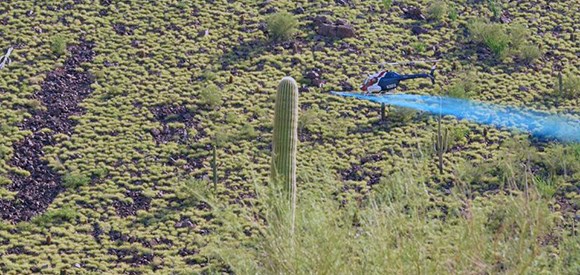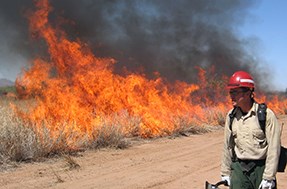Last updated: September 11, 2017
Article
Aerial Treatments Reduce Fire Fuels in the Wildland Urban Interface

The battle against an invasive grass has been taken to a new level. Buffelgrass, native to Africa, is spreading exponentially in the Sonoran Desert. It has resulted in unprecedented fuel loads in Saguaro National Park of 1-4 tons per acre. Buffelgrass is replacing native plants and converting a nearly fire-proof desert plant community into a highly flammable grass-scrubland. In 2014, the park began using aerial herbicide application with a helicopter. Intensive monitoring is occurring.

The battle against an invasive, nonnative grass at Saguaro National Park has been taken to a new level. Buffelgrass (Pennisetum ciliare, also known as Cenchrus ciliaris) is a grass from Africa introduced to several parts of the globe. Due to its aggressive nature, it has been called “one of the world’s most notorious invaders.” It is spreading exponentially in the Sonoran Desert, and has resulted in unprecedented fuel loads in the park, ranging from one to four tons per acre. Buffelgrass is replacing native plants and converting a nearly fire-proof desert plant community into a highly flammable grass-scrubland. The continuous, heavy grass is a serious threat to natural biodiversity, human safety, and property because of the potential for intense wildfires.
The park has been fighting buffelgrass since the early 1990s. Fire funds have aided in this effort since 2008, at times contributing up to one-third of the annual buffelgrass treatment budget. Control efforts include manually pulling plants (mainly by volunteers) and herbicide application by park staff and contracted conservation corps with back-sprayers.
Despite the program’s success in places, buffelgrass is spreading faster than the park can treat it with these methods. In addition, buffelgrass has spread to areas that are too far or steep for ground crews to treat. A Restoration Plan and Environmental Assessment was written with significant public involvement, and aerial spraying was authorized to augment ground-based spraying.
In 2014, the park began using aerial herbicide application with a helicopter, a new tool in the fight against buffelgrass. Aerial and ground treatments were conducted following buffelgrass green-up, using National Park Service Natural Resource Stewardship and Science funds, and other NPS funds, including fire funds. Most of the area treated with either ground or aerial herbicide application was within areas designated as wildland urban interface in the countywide Community Wildfire Protection Plan, and treatments there benefit adjacent property owners as well as park resources.
Because aerial treatments with a broad-spectrum herbicide (with active ingredient glyphosate) are entirely new in the Sonoran Desert, intensive monitoring is occurring on sprayed and adjacent unsprayed areas. More than 1,200 native cacti and trees were monitored using greenness and plant health measures, and plant cover was also monitored. Preliminary results are extremely promising, but monitoring will be a long-term effort to determine true impacts.
More information on the issue is available on the park’s website and the Southern Arizona Buffelgrass Coordination Center’s website, buffelgrass.org.
Contact: Dana Backer, restoration ecologist, and Perry Grissom, fire ecologist, Saguaro National Park
Email: e-mail us
Phone: (520) 733-5179 and (520) 733-5134
